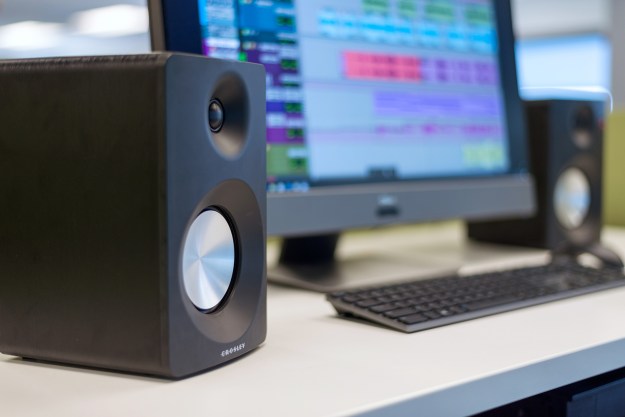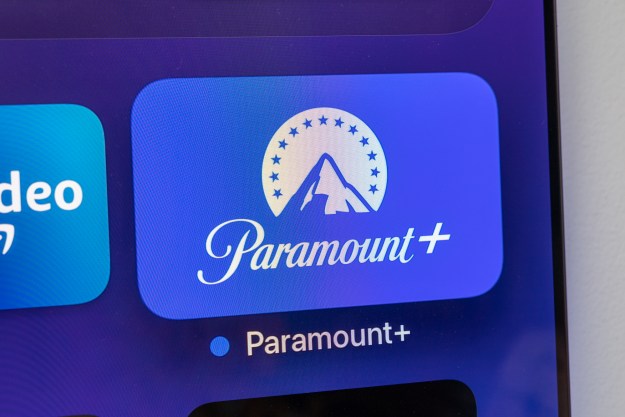
“Crosley Radio’s S100 speakers have their moments, but tinny treble and overcooked bass have us looking elsewhere.”
- Sleek, modern aesthetic
- Midrange instruments sound great
- Both wired and wireless configurations
- Heavily processed sound signature
- Miniscule sweet spot
- Tinny treble response
- Inconsistent bass performance
Gone are the days when getting quality audio meant investing in a veritable legion of amps, receivers, and converters. One-stop solutions are more popular than ever, as speaker sets with built-in amplifiers and wireless connectivity redefine value within an ever-evolving industry. Our Crosley Radio S100 review examines the latest such pair from the storied audio brand.
With the S100, Crosley aims to offer hi-fi sound, with the addition of Bluetooth connectivity, all for a low-fi price. Unfortunately, even priced well below the $200 watermark, these speakers have trouble keeping up with the Johnsons in wireless speaker land. There’s potential, but without a more consistent sound signature or a more specific niche, it’s difficult to give the S100 our stamp of approval.
Out of the box
You’ll find the Crosley Radio S100 speakers nestled in a hefty box, sleeved in polyethylene and buffered between two cardboard molds. There’s little decoration or presentation to speak of; the S100’s home feels designed for safety, not sex appeal.
Removing the speakers from their resting place reveals a few helpful accessories: The AC power cord, an RCA-to-3.5mm auxiliary cable, and six feet of standard speaker wire to connect the stereo speakers.
Features and design
Once free from their box, the S100 speakers offer an attractive design with a hint of flash via the brushed aluminum woofers at the base. They’re predominantly black, with matte front panels and the rest plastered with a wood-grain finish that actually looks pretty nice for the price. Both speakers (unfortunately) feature the Crosley wordmark at the bottom of their face; it’s not ugly, exactly, but it interrupts the minimalist vibe that works best for bookshelf speakers.
Each speaker is outfitted with a black-on-black, 1-inch tweeter up top and each aluminum-brushed woofer measures 4-inches across. Each of the speakers is pushed by a built-in Class D digital amplifier, rated at a claimed 30 watts total power for each speaker at 8 ohms impedance.
Midrange instruments like guitar and vocals sound great when given room to breathe.
At less than ten inches tall and just over seven inches deep, the S100 speakers are fairly compact. Small bass ports at the rear of each speaker provide a bit of extra oomph, while the right speaker is home to all the jacks and controls. The left speaker draws power and sources audio through the included speaker wire, which is relatively short at just around six feet long, but more than enough for our purposes.
Set at the front of the right speaker, the power button glows red when the speakers are connected to power, and once they’re powered on, one tap switches between Bluetooth (blue) and auxiliary (green) sources. Below are volume controls, which operate independently of your connected device’s volume.
On the back of the right speaker, dedicated treble and bass knobs for basic EQ adjustment sit above the stereo RCA input. There’s also a USB port for service only, a power port, and easy-spin gold binding posts (also present on the left speaker), to link the two speakers in stereo. We were disappointed to find no optical input (or a digital input of any kind) on board, meaning these speakers aren’t really set up to connect to sources like your TV – unless your TV is crazy old.
Pairing a device to the speakers via Bluetooth is quick and painless, with a viable range of around 20 feet in practice – less than the usual 33 feet for most Bluetooth speakers. We also found we needed to re-pair our phone when coming back into the room, though the issue was sporadic.
Audio performance
The S100 perform with maddening inconsistency – so much so that it’s difficult to roundly describe the sound without adjusting for source material.
Local Natives’ soulful cover of Kanye West’s Ultralight Beam projects ghostly vocals over wanton electric guitar to great effect, but Young the Giant’s Islands – a similarly slow-burning affair – sounds cheap, with bass notes that lack definition and a conga drum-tambourine combination that comes off garbled and generally unpleasant.
The speakers often struggle to find a balance between bass and treble; even twiddling with the knobs often seemed fruitless during or evaluation, as kick drums went straight from underwhelming to overcooked, heading straight into distortion without passing through any sort of goldilocks zone.
The S100’s sound signature also comes off as fairly processed, with treble that sounds tinny in crowded productions. The midrange is a little bit better, mostly sounding natural, but instruments like horns and violins often lack presence in songs with multiple layers.
For the most part, midrange instruments like guitar and vocals sound great on the S100, when given room to breathe. As such, songs composed with mostly just the two – Ed Sheeran’s I See Fire, for example – really stand out. Similarly, the infectious riffs of Matisyahu’s Sunshine attack crisply and satisfyingly, although synths in the chorus tend to disappear behind a wall of sound.
Electronic music fares pretty well on the S100 – Roland 808 drums and electronic sub-bass sound a bit better than kick drums do, and songs like C2C’s Down the Road are as fun as ever, with well-timed record scratches punctuated by a punchy bassline.
Like any bookshelf speakers, the S100 are beholden to placement; you’ll need to position them at ear level and angle them correctly to bring the best out. Still, the sweet spot is small, and even moving a few inches in the wrong direction offsets the stereo imaging significantly. The speakers also have a hard time reproducing sound evenly across a larger space.
It’s not that the S100 sound bad. It’s just that even when they sound good, they don’t sound particularly natural. They’re built, at least partially, with turntables in mind – and, for some, they do offer an affordable dorm room-style solution — but most people who are willing to invest in vinyl will also want to invest in superior speakers that capture the best qualities of analog music.
Warranty information
Crosley Radio offers a one-year warranty against defects in material and workmanship, only valid in the continental United States, Canada, and any area serviced by an authorized Crosley international distributor. Crosley assumes no responsibility for shipping or packaging fees.
Our Take
The S100 are a fair pair of wireless bookshelf speakers, but they’re not standouts. Portable Bluetooth speakers offer more versatility (with comparable audio quality), while vinyl lovers will want to spend more for a cleaner, more balanced sound. The S100 are probably best suited as large computer speakers, but they’re a little expensive for that role.
Is there a better alternative?
The Edifier Luna Eclipse HD might look weird, but they offer all the same functionality – with better, fuller sound – for a comparable price. Edifier also makes some great passive bookshelf speakers, such as the R1280T, for just $100 (you can even add an affordable amp and still undershoot the S100).
Micca’s PB42X are a shade more affordable than the S100 and have excellent reviews, as do PreSonus’ Eris E4.5, which boast bassier sound for a higher price point. We’d also recommend checking out Grace Digital’s BTSP201 speakers, which are a bit older, but also cost less than the S100 and offer superior sound quality.
How long will it last?
Since you probably won’t be toting the S100 around in your carry-on, we expect they’ll last a reasonably long time. There are no red flags here when it comes to workmanship.
Should you buy it?
No. While these speakers have their moments, the competition in the wireless bookshelf genre is too competitive to settle for mediocre sound.
Editors' Recommendations
- Best OLED TV deals: Save on LG C3, Samsung S90C, and more
- Sonos’ new Era 100 and Era 300 wireless speakers go all-in on spatial audio and Bluetooth
- Samsung S95B OLED hands-on review: Brilliant potential
- Tivoli Model One Digital radio hands-on review: Small changes, big difference








